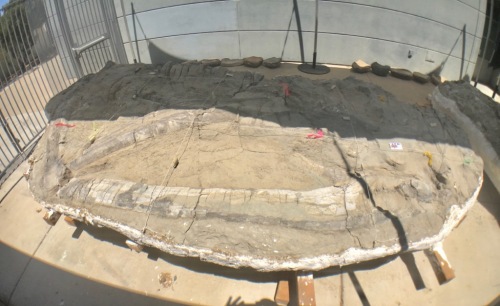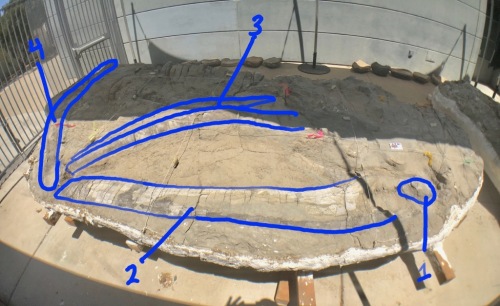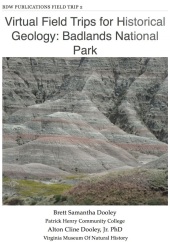 A few weeks ago, Western Science Center took delivery of the first fossil whale in our collection.
A few weeks ago, Western Science Center took delivery of the first fossil whale in our collection.
This specimen was collected by PaleoSolutions during a construction project in Santa Cruz County. There are five separate field jackets, including one monster that’s five meters long! That’s the jacket shown above (notice the tiny scale bar on the right).
This whale was found in Pliocene deposits, between 2 and 5 million years old. California has rich deposits of Pliocene whales, so when we’ve finished preparing this specimen (likely several years from now) there should be a lot with which to compare it. But even now, we can say a few things about it. First, this is a filter-feeding baleen whale from the suborder Mysticeti (hence the publicly-nominated nickname, Mystic). The only toothed whales (odontocetes) that get this large are sperm whales, and none of the visible cranial bones resembles the highly specialized elements in sperm whales. Below is a marked-up image with a few of the visible bones outlined (apologies for the lighting):

The bone labeled “1” is a vertebra, probably a thoracic or lumbar vertebra. This specimen includes numerous vertebrae, and all of them seem to have fused vertebral epiphyses, indicating that the whale is an adult.
Number 2 is the left dentary; the left side of the lower jaw. It’s not clear yet how much of the dentary is preserved, so it may be a bit longer than what is visible here. An interesting and important feature is the apparent absence of a coronoid process. The largest living group of baleen whales, the Balaenopteridae (including blue, fin, and humpback whales, among others) all have a large, prominent coronoid process. That means this specimen is more likely member of the right whale family (Balaenidae) or the grey whale family (Eschrichtiidae). (The weird pygmy right whale also lacks a coronoid process, and may not even be a right whale, but Mystic is not a pygmy right whale.)
Number 3 I think are the premaxillae, which in whales extend from the tip of the upper jaw all the way to near the blowhole. These are strongly arched, which is consistent with both right whales and grey whales, but to me these look a bit more like a right whale.
Number 4 I’m not sure about. I briefly thought is might be the broken continuation of the dentary, but I don’t think that’s right. The shape is wrong, and if you add that to bone 2 the dentary would be up in the blue whale-size range; Mystic isn’t that big! I now think this might be the displaced and rotated maxilla. It should be running parallel to the premaxilla, so if it really is the maxilla it is way out of position, but this isn’t unheard of. That shape is also consistent with a right whale maxilla.
So, if this is a right whale (by no means a certainty), which right whale is it? There are actually only a handful of fossil right whale genera known. Of the four Pliocene genera, tiny Balaenella is only known from northern Europe, and is smaller than Mystic. Balaena includes the living bowhead whale as well as some extinct species. Eubalaena includes the three living right whale species, as well as several extinct ones. Most species of Balaena and Eubalaena are giants, quite a bit larger that Mystic (remember Mystic is an adult). I’m not ready to rule them out, but they seem unlikely. The fourth known Pliocene balaenid is Balaenula, a poorly understood genus that is known from all over the northern hemisphere, including California. Balaenula is a fairly small whale, and I think Mystic is likely a bit larger. But, if Mystic belongs to any right whale genus that has already been described, I think Balaenula is the best candidate.
Mystic is on display in an outdoor preparation area at Western Science Center, so that the public can follow progress on its preparation in the years to come.


